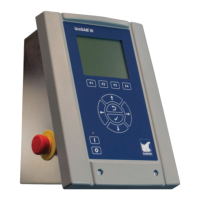Engineering manual - UniSAB III 1.10.8
001930 en 2021.06
71/346
Compressor control and surveillance
will usually pulse the digital outputs with a pulse/delay ratio. Consequently, a constant up or down signal
will rarely be given.
The capacity control must be seen as two PID control loops (an inner and an outer loop). The inner loop,
which is a proportional regulator, adjusts the slide position continuously according to the capacity set
point. In Manual mode the capacity set point is selected with the / keys and in Auto/Remote mode
it is selected automatically by the outer loop. As long as this set point is constant, the inner loop will en-
sure that the capacity slide remains in this position independent of any other outside influences.
The outer loop, which can be a PID or I regulator, adjusts the capacity set point according to the selected
control set point and measured value, e.g. the suction pressure set point and measured value. In Manual
mode, the outer loop is not active. In Auto and Remote, the outer loop is active according to the Control
on setting. See subsection 3.1.2 Regulator set-up.
The inner loop set point can also be controlled via the external input (see subsection 3.1.12 Capacity
control with user input 1) or via the communication network.
3.1.4 Capacity PID regulation (outer loop)
On screw compressors a PID regulator is used for the outer loop of capacity regulation. In the picture
Setup/Compr.Control it is possible to select Capacity Controller = PID or I. If PID is selected, all the pa-
rameters stated below are accessible.
If I is selected only the parameters Actual set point, Set point 1 and 2, Neutral zone and Prop. band are
accessible. The actual parameters are found in the relevant picture, e.g. Control values/Suction/Pres-
sure/Control. Each parameter is briefly described below. The theory behind PID regulation is described
in innumerable books about automatic regulation. These books also describe methods for optimising the
parameters.
Name Description
Actual Sp
The set point the PID controller is currently working with
Set point 1 User selected set point 1
Set point 2 User selected set point 2
Neutral zone The neutral zone is a symmetrical area around Actual set point. When the
controlled value is inside the area, the controller will be passive. The pur-
pose is to increase service life of the output hardware (relays, valves, spin-
dle motor, etc). However, this is also partly ensured by the parameter Min
pulse, see 3.1.5 Capacity P regulation (inner loop) below, which is why the
Neutral zone can be set at 0. An increased Neutral zone makes regulation
less accurate.
Prop. band The proportional band determines the total gain in the control loop. In-
creasing Prop. band provides a slower response. Thus changing Prop.
band does not only affect the proportional term, but also the integral and
differential terms.
T. int.
Integral Time determines the gain of the integral term. A small T. int.
means a large gain, i.e. the controller will try to reach the set point faster.
T. diff. Differential Time determines the gain of the differential term. A large T. diff.
means a large gain. Normally, select T. diff. = 0 which deactivates the dif-
ferential term and makes the regulator work as a PI controller.
P. part
This field shows the actual Proportional term calculated by the PID
controller.
I. part
This field shows the actual Integral term calculated by the PID controller.
D. part
This field shows the actual Differential term calculated by the PID
controller
Reg. output
The actual Regulator output is the sum of P. part, I. part and D. part.
Table 19: Description of regulating parameters

